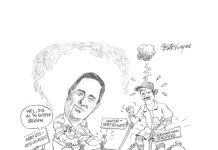Even before COVID-19 arrived the South African economy was in trouble. The official unemployment rate reached 30%, while per capita economic growth had been negative for half a decade.
In fact, looking at five-year periods from 1960, only the period 1990 to 1994 – when South Africa was in the midst of its political transition – saw lower average economic growth than the period 2015 to 2019. Investment as percentage of gross domestic product (GDP) also fell, while the government’s debt position deteriorated substantially, reaching a debt-to-GDP ratio of 63% in the 2019/2020 fiscal year.
Impact of COVID-19
Then COVID-19 struck. In the second quarter of 2020 2,2 million people lost their jobs – meaning one in eight people who had a job in the first quarter, lost it in the second. GDP, which measures total production in the economy, was 17,1% smaller in the second quarter compared to a year earlier.
The second half of 2020 will show a rebound, with some people finding jobs again and economic growth making up some lost ground. Nevertheless, it is generally expected that for the whole year, GDP will shrink by roughly 8% to 9%. The COVID crisis also had a profound impact on government’s finances, as did further bailouts of troubled state-owned enterprises such as SAA and Eskom. As a result, government’s debt burden is set to increase from 63% to 82% of GDP in the 2020/2021 fiscal year.
Rebuilding the economy
This means that the foundation on which South Africa has to rebuild its post-COVID economy is anything but solid. However, these problems should not make us blind to the possibilities that exist. South Africa survived the Spanish flu of 1918, during which 300 000 South Africans, representing 6% of the population at the time, died within a six-week period. South Africa also survived the Great Depression of 1929 as well as the political and economic turbulence of the 1980s and early 1990s. After each of these severe crises the economy rebounded. As recently as the period 2003 to 2008 the economy was still growing at between 3% and 5,5% per year. We can get there again and solve the problems we face.
What we need is economic growth, because a growing economy generates jobs and income, which – in the final analysis – is the only solution to reduce poverty and inequality. To create that growth, South Africa needs significantly higher levels of investment. Government policy should therefore focus on restoring investor confidence and conditions that will improve profitability. Empirical analysis shows that for every percentage point we increase private sector investment as percentage of GDP, we increase economic growth by a third of a percentage point. Thus, if we can succeed in raising private sector investment (which is around 12% of GDP) to 18% of GDP, we will raise GDP growth by two percentage points per year.
To put this in perspective: At an economic growth rate of 1,5% it takes approximately 47 years to double the size of the economy. At 3,5% (which is two percentage points higher), it will take in the region of 20 years. If you are 25 years old, it is the difference between doubling the size of the economy by the time your children will enter the labour market versus the time when your grandchildren will do so. With population growth at roughly 1,5% per year, it is also the difference between no improvement in per capita income and an improvement of 2% per year.
How do we get there? According to the Council for Scientific and Industrial Research (CSIR), South Africa’s urban population will increase with up to 14 million people between 2018 and 2035, reaching between 50 million and 52 million in 2035. Rural areas will see a slight decrease in population.
These new urban migrants will need houses, shops, places of worship and entertainment. They will need water, electricity, roads and transport. Thus, there will be great opportunities for investment and job creation. What they will also need is food, leading to enormous opportunities for expanding agricultural production. In this way urbanisation can serve as a foundation for a thriving rural economy.
Creating thriving rural areas
In South Africa rural areas include more than just commercial activity. The so-called deep rural areas refer to the communal land areas where almost a third of South Africa’s population largely lives on a subsistence agricultural basis. Communal land areas are largely the same areas that constituted the former homelands in apartheid South Africa.
To alleviate poverty and create economic opportunities for people living on communal land will require an environment that will allow small-scale farmers on communal land to commercialise their activities. This will require securing their tenure rights on communal land and embedding the small-scale farmers in supply chains to reduce input costs and create markets for their produce.
Securing tenure rights is not necessarily the same as securing property rights. Quite a number of people living on communal land have overlapping land use rights. In other words, once one person’s harvest is in, another’s cattle can graze the land, while community members can collect wood and water from the land. Securing tenure rights in the form of overlapping land use rights in law can allow occupants to pledge the future stream of income from harvests as collateral for production and capital loans. This allows them to produce more than mere subsistence levels of output and therefore produce for the market. While government should secure tenure rights, both government and commercial and organised agriculture should assist in the development of the supply chains in which to embed such small-scale farmers.
Though South Africa currently finds itself in deep economic trouble, it can get out of that trouble by growing the economy. It can grow its economy by growing its cities to cater for the millions who will move there in the next 15 years. Paradoxically, such an urban-focussed policy also creates the opportunity for thriving rural areas and a growing and inclusive agricultural sector.
















